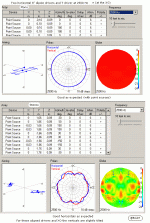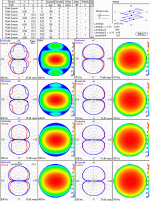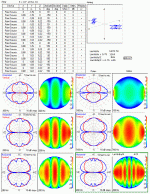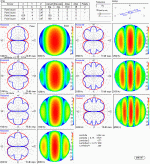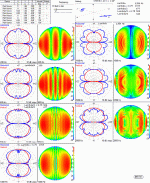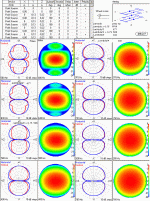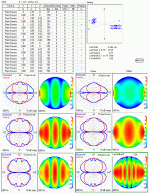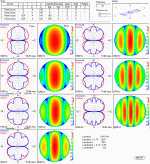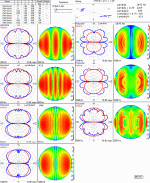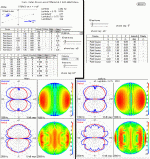Re: Take a Peek
Well Lynn I'm sorry I didn't drag you down to the 5th floor in Denver to hear the big OBs. 4x12" per side. 3 of them powerful Eminence auto subs, 1 Beta 12LTA for the mids + a tweeter.
These things would flap your pant leg and you could feel the floor shake out in the hall. Not bad for OB. And bass drum and tympani were sweet - you could really hear the decay of the bass drum note, no box resonances to get in the way.
I've not heard bass that big and clean since the Onken-W cabs.
I'm sure the current Magantar project is as good or better. It can be done, and it's not that hard. (Just heavy)
Lynn Olson said:This is the point I've been trying to make all along - dipoles don't have to be a "wuss" when it comes to impact, dynamics, and confident power-handling.
Well Lynn I'm sorry I didn't drag you down to the 5th floor in Denver to hear the big OBs. 4x12" per side. 3 of them powerful Eminence auto subs, 1 Beta 12LTA for the mids + a tweeter.
These things would flap your pant leg and you could feel the floor shake out in the hall. Not bad for OB. And bass drum and tympani were sweet - you could really hear the decay of the bass drum note, no box resonances to get in the way.
I've not heard bass that big and clean since the Onken-W cabs.
I'm sure the current Magantar project is as good or better. It can be done, and it's not that hard. (Just heavy)
SunRa post #2447:
FYI:
I made a couple of simple dipole point source simulations which of course isn’t the whole true but reveals a lot, at least within +- 15 degree azimuth.
Serious horizontal dispersion problems (+ summed localisation smear = wide central phantom at 10’, atan (8”/10’) = 3.8 degree horizontally) can be seen when using the horizontal placed 8” drivers + crossing over high at 2500 Hz if stereo, picture5 (5), but looks good at lambda x 0.75 or lower and if placed centrally, picture 4(5) as a mono speaker, even better.
The 5 x bass speakers works ok below lambda/4 and the stereo combing (observe at t=0 and no baffle or wall reflexes) at XO looks as expected (normal 200Hz combing with this speaker separation) and should perform well.
b
1(5)
…what do you think about the horizontal placement of the midrange drivers in magnetar's sistem…
FYI:
I made a couple of simple dipole point source simulations which of course isn’t the whole true but reveals a lot, at least within +- 15 degree azimuth.
Serious horizontal dispersion problems (+ summed localisation smear = wide central phantom at 10’, atan (8”/10’) = 3.8 degree horizontally) can be seen when using the horizontal placed 8” drivers + crossing over high at 2500 Hz if stereo, picture5 (5), but looks good at lambda x 0.75 or lower and if placed centrally, picture 4(5) as a mono speaker, even better.
The 5 x bass speakers works ok below lambda/4 and the stereo combing (observe at t=0 and no baffle or wall reflexes) at XO looks as expected (normal 200Hz combing with this speaker separation) and should perform well.
b
1(5)
Attachments
Hi
CLS, yes exactly !
What you get by BL / mms basically is a figure for the max acceleration of that speaker cone and this translates to SPL-impulse rise time over the effective cone area. So you have to normalise / multiply your numbers by the effective cone area.
After that display X-lin-max in the next row as it is easy to construct motors with high BL with low X-lin-max only! An other trade off would be to use a lot of windings within the gap which increases the coil inductance – normally . A increased VC diameter is one way to optimise the BL versus L ratio faraday rings is an other one .
Greetings
Michael
CLS said:How much should we expect from a "high ratio of BL product to cone mass"?
....
So, it seems the cone area (or the whole loading) of the driver should be considered? But how? Taking a further product with cone area?
CLS, yes exactly !
What you get by BL / mms basically is a figure for the max acceleration of that speaker cone and this translates to SPL-impulse rise time over the effective cone area. So you have to normalise / multiply your numbers by the effective cone area.
After that display X-lin-max in the next row as it is easy to construct motors with high BL with low X-lin-max only! An other trade off would be to use a lot of windings within the gap which increases the coil inductance – normally . A increased VC diameter is one way to optimise the BL versus L ratio faraday rings is an other one .
Greetings
Michael
Hi
Play with numbers:
The favourite FOSTEX FE103 compared to ancient DYNAUDIO 30W54 ( Sd = 400 cm / mms = 42 g / BL = 9,44 Tm / X-lin = 7 mm ) http://www.gattiweb.com/images/dynaudio/30w54_data.pdf
(( BL / mms ) * Sd ) for DYNAUDIO = 92
(( BL / mms ) * Sd ) for FOSTEX = 105
( X lin-max * Sd ) for DYNAUDIO = 280
( X lin-max * Sd ) for FOSTEX = 1,75
See what I mean ?
The ancient DYNAUDIO with its low BL is roughly as " speedy " as the FOSTEX and is 100 times better than the FOSTEX in displacement volume. Sure the DYNAUDIO has to give up earlier than the FOSTEX due to cone break up.
Surprising, no ?
With jets when the force factor exceeds the weight they are capable to go straight up – same relations basically here.
Greetings
Michael
mige0 said:Hi
CLS, yes exactly !
What you get by BL / mms basically is a figure for the max acceleration of that speaker cone and this translates to SPL-impulse rise time over the effective cone area. So you have to normalise / multiply your numbers by the effective cone area.
Greetings
Michael
Play with numbers:
The favourite FOSTEX FE103 compared to ancient DYNAUDIO 30W54 ( Sd = 400 cm / mms = 42 g / BL = 9,44 Tm / X-lin = 7 mm ) http://www.gattiweb.com/images/dynaudio/30w54_data.pdf
(( BL / mms ) * Sd ) for DYNAUDIO = 92
(( BL / mms ) * Sd ) for FOSTEX = 105
( X lin-max * Sd ) for DYNAUDIO = 280
( X lin-max * Sd ) for FOSTEX = 1,75
See what I mean ?
The ancient DYNAUDIO with its low BL is roughly as " speedy " as the FOSTEX and is 100 times better than the FOSTEX in displacement volume. Sure the DYNAUDIO has to give up earlier than the FOSTEX due to cone break up.
Surprising, no ?
With jets when the force factor exceeds the weight they are capable to go straight up – same relations basically here.
Greetings
Michael
…Interesting, now put a 6db (90 degrees out of phase) high pass at 1K on the inside midrange…
I don’t think a high pass a capacitor in series with the inside midrange would help the dispersion and blur problem but the opposite would:
A low pass filter, a series inductance at 1 kHz on the outer drivers solves both the horizontal blur + dispersion issues.
b
1(1)
Attachments
ScottG said:I suspect that the PHY-HP H 21 LB 15 SAG is exactly the midrange driver Lynn is looking for. Its not cheap though.
Some subjective comments can be read here (last 3rd of page):
http://www.6moons.com/audioreviews/ocellia/ocellia_5.html
Specs look good. I treat 6 Moons, Enjoythemusic, Absolute Sound, and Stereophile recommendations with a considerable degree of wariness - I tend to dislike what they like, so a recommendation is actually a potential negative for me. However, as the saying goes, even a blind pig finds an acorn occasionally, so once in a blue moon the reviewers stumble across something good.
The specs of the H 21 LB 15 and the more pricey H 21 LB 15 SAG look reasonable enough, and I guess the only difference between the two is the silver voice coil with silk insulation. Dunno about the merits of silver vs increased VC mass. They're not cheap at 596 and 736 euros respectively, but that's not quite as much as a Lowther, AER, or even more stratospheric Feastrex.
They do look like a good match for the ultrafast and dynamic RAAL tweeters, with a moving mass of 5.9 grams and extension out to 10 kHz, giving a wide range of potential crossover frequencies, anywhere from 2 to 10 kHz.
Hmm, OK, a quartet of series-parallel 12NDA520's, the lower (or inside) pair with a moderate-gauge air-core inductor to raise Qts and reduce output above 120~160 Hz, the aforementioned PHL, and most likely a single-high RAAL tweeter, since the RAAL has a de facto 2.5 dB efficiency gain at 3~4 meters thanks to narrower vertical directivity compared to conventional dome drivers. System efficiency would be around 98 dB/metre, quite OK for a 15-watt DHT amplifier with 30~40 watt peak capability.
I own a pair of the Phy's (and still listening to them) and thought they where pretty expensive at that time. Well that was almost pocket money compared to the amount I have spent to find a good combining tweeter for them, very difficult, but in the end worth it.
Have to mention that I'm using them with two jbl 15" woofer per side and even then I think Lynn might not like them when I read about the kind off headroom he is searching for. I never ever play loud music so for me it's satifying. (gonna try some low-mid fill in anyway soon) If I would play louder I would go with some bigger cone area to fill in the lower mids and cross the phy's at 300, maybe even 400hz at least.
I don't like them in the ocelia, auditorium23, musical affaris designs, just a plain baffle sounds best, but then you don't have bass and weak low-mids. but better that then trying to get it from the cabinet, specially if you like to listen to hip-hop and electronic music occasionally like I do.
They need a tweeter that's for sure (and some wooferes too offcoarse) unlike some people would like you to believe. If you definatly don't want to use a tweeter you're much better off bying something like the visaton's b200's (had them as well) and even these do need a tweeter in my opinion
by the way, I have owned some of the 6,5 inch and 8 inch PHL drivers as well and have to say they are quite nice but when I switch over to the Phy's the Phl sound quite a bit "stessed", the Phy are more lush and easy on the ear. The Phl seem to have more impact but that's also due to their stress.
Have to mention that I'm using them with two jbl 15" woofer per side and even then I think Lynn might not like them when I read about the kind off headroom he is searching for. I never ever play loud music so for me it's satifying. (gonna try some low-mid fill in anyway soon) If I would play louder I would go with some bigger cone area to fill in the lower mids and cross the phy's at 300, maybe even 400hz at least.
I don't like them in the ocelia, auditorium23, musical affaris designs, just a plain baffle sounds best, but then you don't have bass and weak low-mids. but better that then trying to get it from the cabinet, specially if you like to listen to hip-hop and electronic music occasionally like I do.
They need a tweeter that's for sure (and some wooferes too offcoarse) unlike some people would like you to believe. If you definatly don't want to use a tweeter you're much better off bying something like the visaton's b200's (had them as well) and even these do need a tweeter in my opinion
by the way, I have owned some of the 6,5 inch and 8 inch PHL drivers as well and have to say they are quite nice but when I switch over to the Phy's the Phl sound quite a bit "stessed", the Phy are more lush and easy on the ear. The Phl seem to have more impact but that's also due to their stress.
Audax
Obviously this isn't my project, but I think the Audax PR170MO is worth considering. I am shocked at the sound produced by this magnificent driver. It's PHL equivalent, the 1120 is also a contender in my book, but again it isn't my project. For the money you spend to try a PHL or the Audax, it is well worth it. Think horn dynamics without horn coloration. That last statement wasn't meant to start a flame war with the horn camp either.
C
Obviously this isn't my project, but I think the Audax PR170MO is worth considering. I am shocked at the sound produced by this magnificent driver. It's PHL equivalent, the 1120 is also a contender in my book, but again it isn't my project. For the money you spend to try a PHL or the Audax, it is well worth it. Think horn dynamics without horn coloration. That last statement wasn't meant to start a flame war with the horn camp either.
C
Thanks for the comments from an owner, always much more informative than a reviewer with their terrible sense of taste (reviewers are the guys that actually like Wilson Audio and Magico Minis). Much appreciated!
I have a sense all of the wideband exotics are going to need a 200~400 Hz highpass filter to get good dynamics, and keep the Xmax in the reasonable range. None of these drivers are linear when the VC is asked to move more than a mm or two - if you can see the cone moving, it's too much.
The low power rating is the result of a paper VC former, but since I'm not aiming for PA use, I don't think the risk of scorching the paper is that great (that takes sustained high-power abuse). If I had a 200 watt-per-channel amplifier and was planning to use them in a recording studio on a day-in day-out basis, that would be another matter altogether.
So I guess the real question is how suitable is the PHY, or any of the exotics, in the 200~400 Hz to 2~4 kHz range? Good enough they're (substantially) better than the prosound equivalents at a quarter the price?
I have a sense all of the wideband exotics are going to need a 200~400 Hz highpass filter to get good dynamics, and keep the Xmax in the reasonable range. None of these drivers are linear when the VC is asked to move more than a mm or two - if you can see the cone moving, it's too much.
The low power rating is the result of a paper VC former, but since I'm not aiming for PA use, I don't think the risk of scorching the paper is that great (that takes sustained high-power abuse). If I had a 200 watt-per-channel amplifier and was planning to use them in a recording studio on a day-in day-out basis, that would be another matter altogether.
So I guess the real question is how suitable is the PHY, or any of the exotics, in the 200~400 Hz to 2~4 kHz range? Good enough they're (substantially) better than the prosound equivalents at a quarter the price?
- Home
- Loudspeakers
- Multi-Way
- Beyond the Ariel
